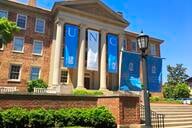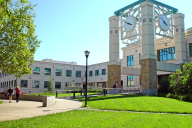You have /5 articles left.
Sign up for a free account or log in.
The average salary of a full-time faculty member increased by 1.7 percent in 2012-13, roughly keeping pace with inflation, according to a report being released today by the American Association of University Professors. While the average increase was a bit larger last year (1.8 percent), a drop in the inflation rate from 3.0 to 1.7 percent means that this year's modest raises will add to spending power for many faculty members, while last year's did not. Indeed in each of the prior three years, the average overall increase in salaries was less than the rate of inflation.
The increases in average salary were far from uniform. Gains were larger at private than at public institutions, and gains were larger at doctoral institutions than in other sectors. In other words, the (relatively) wealthy got wealthier. Indeed, even as many professors whose salaries are reported in the survey may not feel they have made it into the middle class, there are five universities this year (all private) where for the first time, the average salary of a full professor tops $200,000.
Here are the average percentage gains that the AAUP found by sector and rank:
Percentage Change in Average Salary, 2011-12 to 2012-13 by Rank and Sector
| Rank | All | Public | Private, Independent | Private, Religious |
| Full professor | +2.1% | +1.6% | +3.0% | +2.4% |
| Associate | +1.7% | +1.5% | +2.0% | +1.6% |
| Assistant | +2.1% | +2.0% | +2.3% | +2.3% |
| Instructor | +2.0% | +1.7% | +3.3% | +2.9% |
| All | +1.7% | +1.3% | +2.4% | +2.1% |
The AAUP report notes repeatedly that the salaries covered in this study represent a minority (and a shrinking minority at that) of those teaching in American higher education. While full-time, non-tenure-track faculty members are included, part-timers are not. So while adjuncts are doing a larger and larger share of teaching, their pay levels aren't reflected here. Given that adjuncts tend to earn a fraction of what tenure-track professors take home, and that benefits are generally minimal (if there are any), an overall economic picture of the American professoriate would be much bleaker than this one.
Even with those caveats, the AAUP report notes many disparities in pay for those in certain faculty ranks, and the issue of public-private disparities receives a great deal of attention. A full professor at a private, non-religious doctoral university earns on average more than $40,000 more than one at public institution. The average assistant professor at a private, independent doctoral university earns more than the average full professor at either public master's or baccalaureate institutions, or at community colleges.
Average Salary by Sector and Rank, Full-Time Faculty, 2012-13
| Category / Rank | All | Public | Private, Independent | Private, Religious |
| Doctoral | ||||
| --Full professor | $134,747 | $123,393 | $167,118 | $139,194 |
| --Associate | $88,306 | $84,275 | $104,016 | $94,199 |
| --Assistant | $76,822 | $73,212 | $90,622 | $79,489 |
| --Instructor | $51,116 | $48,359 | $63,269 | $63,830 |
| --Lecturer | $57,225 | $54,382 | $66,519 | $58,942 |
| Master's | ||||
| --Full professor | $92,552 | $88,988 | $104,186 | $94,031 |
| --Associate | $73,103 | $71,343 | $78,125 | $73,114 |
| --Assistant | $62,184 | $61,041 | $66,050 | $61,487 |
| --Instructor | $47,098 | $45,258 | $52,899 | $51,987 |
| --Lecturer | $49,626 | $48,086 | $58,312 | $52,966 |
| Baccalaureate | ||||
| --Full professor | $91,935 | $86,427 | $104,335 | $78,629 |
| --Associate | $70,334 | $70,066 | $76,993 | $63,244 |
| --Assistant | $58,406 | $58,591 | $62,763 | $53,901 |
| --Instructor | $47,915 | $47,798 | $49,990 | $45,802 |
| --Lecturer | $52,116 | $49,064 | $60,939 | $43,831 |
| Associate (with ranks) | ||||
| --Full professor | $74,526 | $74,845 | n/a | n/a |
| --Associate | $60,821 | $60,876 | n/a | n/a |
| --Assistant | $52,643 | $52,754 | n/a | n/a |
| --Instructor | $45,244 | $45,314 | n/a | n/a |
| --Lecturer | $45,824 | $45,819 | n/a | n/a |
The report accompanying the data -- by John Curtis, director of research and public policy at the AAUP, and Saranna Thornton, professor of economics and business at Hampden-Sydney College and chair of the AAUP's Committee on the Economic Status of the Profession -- acknowledged an overall better story to tell this year in terms of faculty salaries. But the report stressed "important long-term trends that are still heading in the wrong direction for higher education."
One of them is the growing gap between salaries at public and private colleges and universities. And the AAUP released data and tables highlighting those differences by noting the "salary disadvantage" for public college faculty members. The figures refer to the percentage less than comparable private college professors that they earn:
Caveats are important. Salary comparisons here don't reflect cost of living variation among geographic areas. Many a faculty member living in a college town might -- with a smaller salary -- be able to afford a nicer home and have an overall higher standard of living than some faculty members on these lists whose universities are in expensive urban locations. Likewise, there is wide variation in salaries by disciplines, even at the same institutions. Two institutions might pay their English professors roughly at the same level, but if one institution had a much larger number of engineering or business professors, the overall institutional average would be higher. However many caveats we offer, however, people want to know who is on top and how they are doing.
For the first time in 2012-13, the average full professor's salary at the best-paying institutions -- all private research universities -- topped $200,000. Five universities have averages of more than $200,000, while last year's top average was $198,400 (for Harvard University). This year, Harvard is among those topping $200,000 but fell to fourth, with Columbia University leading the way, at least according to the current data.
When Inside Higher Ed asked Columbia about its large increase in average salary for full professors this year, a spokesman said that some of the increase was due to a pilot program in which some faculty members were receiving funds for housing expenses. Curtis of the AAUP said that this sounds like compensation that should be counted as benefits, not salary, and that the association would re-evaluate the Columbia data, which could see its average decrease a bit. But the association is releasing the study with Columbia's current figures. The order of the others in this list of top private research universities, from Princeton on, is unchanged from last year.
Top Private Universities in Faculty Salaries for Full Professors, 2012-13
| University | Average Salary |
| 1. Columbia University | $212,300 |
| 2. Stanford University | $207,300 |
| 3. University of Chicago | $203,600 |
| 4. Harvard University | $203,000 |
| 5. Princeton University | $200,000 |
| 6. New York University | $187,600 |
| 7.University of Pennsylvania | $187,000 |
| 8. Yale University | $186,300 |
| 9. Duke University | $180,200 |
| 10. California Institute of Technology | $179,200 |
The gap between public and private universities is evident in the list of top-paying public universities for full professors. The top institution -- University of California at Los Angeles -- wouldn't make the top 10 private list. And some of those on the public list are essentially flat from a year ago, with New Jersey Institute of Technology seeing its average grow by only $100 and the University of Michigan seeing its total drop by $100.
UCLA moved up from the second spot to the first spot (displacing NJIT). The University of Texas at Austin and the University of Virginia, which were not on the list last year, make it this year. The University of Maryland at Baltimore dropped off, and the University of North Carolina at Chapel Hill is not in this year's data from the AAUP because its statistics were not provided to the association.
Top Public Universities in Pay for Full Professors, 2012-13
| University | Average Salary |
| 1. University of California at Los Angeles | $167,000 |
| 2. New Jersey Institute of Technology | $166,700 |
| 3. University of California at Berkeley | $158,900 |
| 4. Rutgers University at Newark | $154, 700 |
| 5. Rutgers University at New Brunswick | $151,000 |
| 6. University of Michigan at Ann Arbor | $148,700 |
| 7. Rutgers University at Camden | $145,000 |
| 8. University of Texas at Austin | $144,000 |
| 9. University of Virginia | $143,200 |
| 10. University of Texas at Dallas | $143,100 |
For liberal arts colleges, the top three in pay for full professors (in order, Wellesley, Claremont McKenna and Barnard Colleges) remain unchanged from last year in their rank. Smith College fell off the top-10 list while Wesleyan University joined it. Pomona and Swarthmore moved up on the list, nudging others downward.
Top Public Liberal Arts Colleges in Pay for Full Professors, 2012-13
| College | Average Salary |
| 1. Wellesley College | $152,300 |
| 2. Claremont McKenna College | $145,400 |
| 3. Barnard College | $143,000 |
| 4. Pomona College | $142,800 |
| 5. Harvey Mudd College | $139,200 |
| 6. Swarthmore College | $137,900 |
| 7. Amherst College | $137,700 |
| 8. Williams College | $137,200 |
| 9. Wesleyan University | $133,700 |
| 10. Colgate University | $133,000 |
The number of institutions with six-figure average salaries for assistant professors grew this year from 9 to 11, and with Babson College falling from the list, three joined it: Bryant, Columbia and New York Universities. All the institutions on this list are private, except for the last one, Rutgers University at Newark.
Universities With 6-Figure Average Salaries for Full-Time Assistant Professors
| University | Average Salary |
| 1. University of Pennsylvania | $116,200 |
| 2. Harvard University | $113,400 |
| 3. California Institute of Technology | $112,800 |
| 4. Stanford University | $111,300 |
| 5. Massachusetts Institute of Technology | $106,300 |
| 6. Columbia University | $105,800 |
| 7. New York University | $105,300 |
| 8. Bryant University | $104,900 |
| 9. Carnegie Mellon University | $103,900 |
| 10. University of Chicago | $102,700 |
| 11. Rutgers University at Newark | $100,700 |





